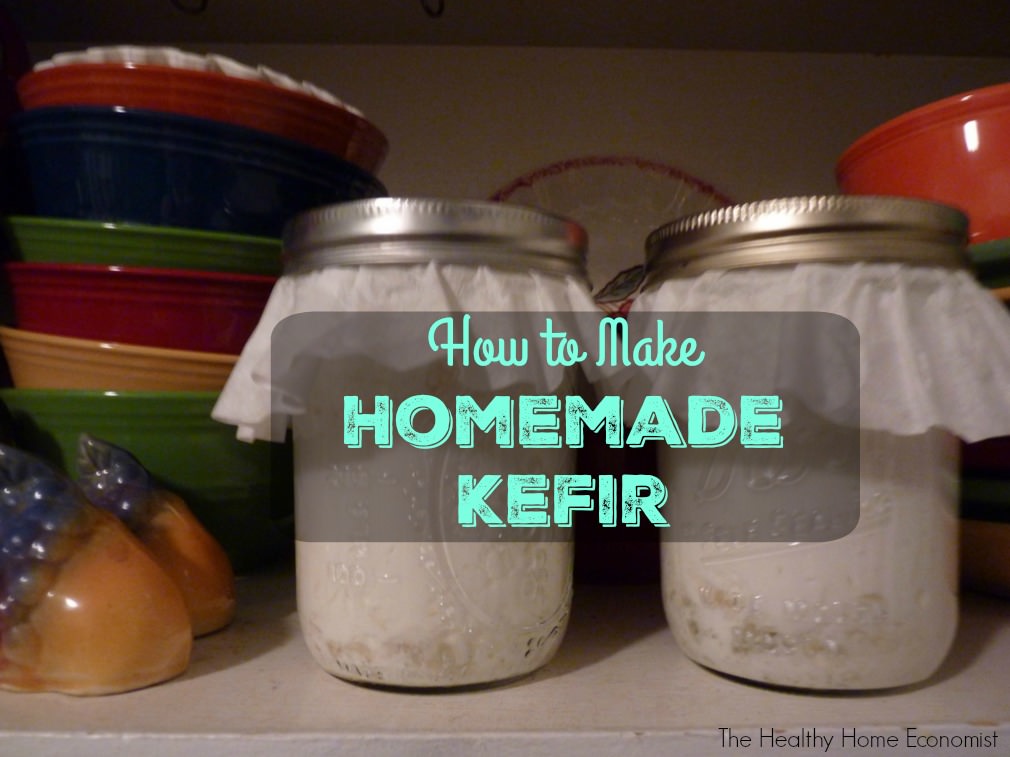Table of Contents[Hide][Show]
How to make homemade kefir the traditional way by fermenting on the counter for 24 hours with farm fresh milk.

I prefer homemade kefir to yogurt because yogurt only has 2-5 strains of beneficial bacteria None of these aggressively attack and destroy pathogens in the gut like the probiotics in kefir do.
By the way, kefir is pronounced ku-feer (not kee-fer or ke-fer).
Kefir made at home has dozens of beneficial bacterial strains as well as several beneficial yeasts. Kefir compared to yogurt is no competition. Kefir is much more beneficial for gut healing.
The one catch is that you need to learn how to make kefir yourself!
Commercial kefir brands typically have far less microbial strains and are not fermented long enough to have the same benefits.
Homemade Kefir Benefits
In a gut that is dominated by pathogens and candida overgrowth (as in someone who has taken many rounds of antibiotics and other prescription drugs over the years and/or eats primarily processed foods), yogurt tends to have only a temporary beneficial impact.
As mentioned earlier, homemade kefir has about 30 beneficial strains of bacteria and yeasts that do aggressively recolonize the gut by destroying pathogens.
As a result, kefir has the potential to permanently alter the gut environment for the better whereas yogurt does not.
The best way to make homemade kefir is to obtain live kefir grains from a friend. They grow slowly over time and extras can be given away (or even eaten as a live probiotic).
Avoid using powdered starter for kefir. It has little to no therapeutic value.
If you cannot find any live grains in your community, you can mail order them.
Other Types of Kefir Made at Home
If learning how to make other types of kefir interests you, check out this video on how to make water kefir.
This video plus recipe on how to make coconut milk kefir is helpful if you wish to make a dairy-free version of the milk-based kefir below.

Homemade Kefir Recipe
Easy recipe for homemade kefir fermented on the counter for 24 hours to maximize beneficial microbial strains for gut healing.
Ingredients
- 1 quart raw milk preferably grass-fed
- 1 wide-mouthed mason jar
- live kefir grains
Instructions
-
Pour the raw milk into a clean glass mason jar leaving about 1 inch at the top. You can use cold milk right out of the refrigerator if this is more convenient. Gently stir in live kefir grains. Roughly one-quarter cup of grains is sufficient to ferment the entire quart.
-
Screw on the lid and leave on the counter at room temperature for 24 hours. Over this time, you will see the milk slightly separate and thicken.
-
The kefir should be ready after 24 hours of fermentation time. If powder culture was used, you can use the kefir as is. If live kefir grains were used, gently strain them out to use again with the next batch of raw kefir.
Recipe Video
Recipe Notes
You do not need to rinse live kefir grains before using again. Rinsing them slightly weakens them in my experience.
Homemade kefir will last many weeks in the refrigerator, but its flavor will get stronger over time.








I am REALLY trying to like kefir, but I’m having trouble getting past the sourness. Any ideas? Thank you.
In your video, you use lids when making kefir and in storing your grains. I heard that it needs to breathe and you should cover it with a clean cloth or coffee filter. Does it need to breathe?
Hi Sarah,
Great video. I have a question around the long-term storage of the milk kefir grains. You mention putting them in a jar of milk in the fridge. A number of sites tell you for storage over a few weeks, you MUST dehydrate or rinse them and store them in the fridge in water. I much prefer your recommendation. I don’t want to dehydrate and then wait for rehydration. And putting the grains in water sounds like starving the poor things. 😉 Would you mind addressing the pros/cons of all the various processes and when/if you would recommend one process over the others?
Thanks,
Susan
I’d like to start making kefir, but would like to know – once it’s ready to refrigerate, how long will it keep in the refrigerator?
Hi Sarah,
I got some grains from a friend, and what I have left in the bottom after 2 batches is a clumpy runny chunk, much like soft crumbly tofu . I do not have a cauliflower bloom like you. Is that okay, will it at some point grow into the cauliflower?
Gail
No, it is always like cauliflower. I don’t really understand what you have there, but it may be water keifer grains and not milk keifer grains. I’ve seen folks make this mistake before.
I’ve been culturing my grains a little over a month from the dehydrated Cultures For Health grains. My grains went through a stage just like yours, I just scraped up the jellyfish mass from the bottom of the jar and strained it. FINALLY my kefir grains look like cauliflower! It was a totally natural stage for the jellylike grains, don’t worry! 🙂
Sarah, do you know of any moms who are using raw milk kefir to help the guts of their autistic children? Thanks for the video … they are such a blessing 🙂 I got some Body Ecology grains (I guess this is the powdered type). Will try that first (since I already have it) and then will order from Cultures for Health.
Hey Sarah,
My family is just getting started with real food & my dad wants to know if cultured butter (kerrygold) has the same benifits as cultured milk kefir as he does’nt like the taste of milk left out over night….thanks for all the info you make so easily available!
Hi Erica, kefir has different benefits than cultured butter. Kefir has over 20 different strains of probiotic many of which are strains that aggressively recolonize the gut crowding out any pathogenic strains that may have taken hold. Have your dad mix the kefir with some fruit and maybe a dash of honey to help the taste be less sour.
I received my kefir grains about 4 weeks ago and have been making it ever since. My kids and I all have a smoothie every morning, and my culture has tripled in size (understand that I started out with 1 cup of kefir culture since I wanted to be able to make a quart easily everyday). I do use about 1 cup culture in a quart of milk, and have a noticeable separation of curds and whey by 12 hours. From what I have researched, it appears that after 48 hours (I do a secondary fermentation for 24 hours w/out the culture in it) the whey becomes a complete protein and there’s quite a bit more B vitamins, plus it’s carbonated!
Hi Sarah! Great Post!
In an effort to rebuild my gut and lose a good 20 pounds of weight, I’m starting to make raw milk kefir.
I’m open to many points of view but found many health advocates saying that if you’re planning on losing weight youshould cut the dairy (even the kefir!) out becaue the sugar in the milk will cause your insulin to spike, therefore encouraging your cells to store fat.
I’d love to get your input on this and thanks again for the great info!
Hi Bettina, raw kefir has little to no milk sugar (lactose) as it is used up by the beneficial flora during fermentation.